自己整理的部分英语语法
- 格式:pdf
- 大小:675.57 KB
- 文档页数:18
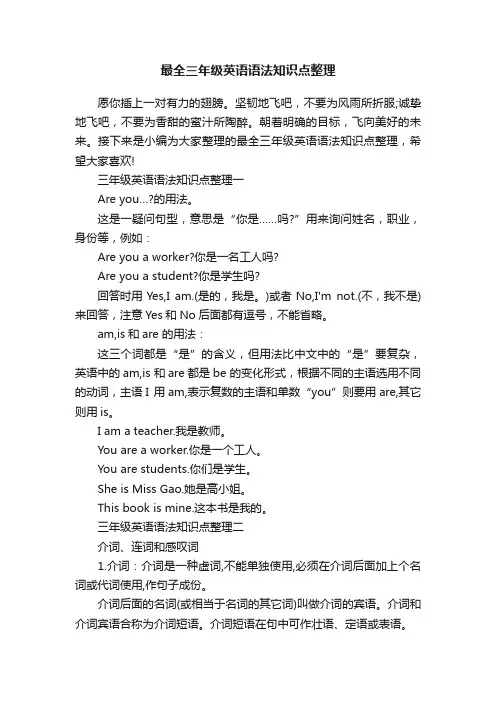
最全三年级英语语法知识点整理愿你插上一对有力的翅膀。
坚韧地飞吧,不要为风雨所折服;诚挚地飞吧,不要为香甜的蜜汁所陶醉。
朝着明确的目标,飞向美好的未来。
接下来是小编为大家整理的最全三年级英语语法知识点整理,希望大家喜欢!三年级英语语法知识点整理一Are you…?的用法。
这是一疑问句型,意思是“你是……吗?”用来询问姓名,职业,身份等,例如:Are you a worker?你是一名工人吗?Are you a student?你是学生吗?回答时用Yes,I am.(是的,我是。
)或者No,I'm not.(不,我不是)来回答,注意Yes和No后面都有逗号,不能省略。
am,is和are 的用法:这三个词都是“是”的含义,但用法比中文中的“是”要复杂,英语中的am,is 和are都是be 的变化形式,根据不同的主语选用不同的动词,主语I 用am,表示复数的主语和单数“you”则要用are,其它则用is。
I am a teacher.我是教师。
You are a worker.你是一个工人。
You are students.你们是学生。
She is Miss Gao.她是高小姐。
This book is mine.这本书是我的。
三年级英语语法知识点整理二介词、连词和感叹词1.介词:介词是一种虚词,不能单独使用,必须在介词后面加上个名词或代词使用,作句子成份。
介词后面的名词(或相当于名词的其它词)叫做介词的宾语。
介词和介词宾语合称为介词短语。
介词短语在句中可作壮语、定语或表语。
介词如: in 在…里面on在…上面under在…下面等。
in the classroom in the tree in the hallon the road on the desk on the floorunder the table under the bed under the chair2.连词:连词是用来连接词与词、短语与短语、句子与句子等的词叫连词。
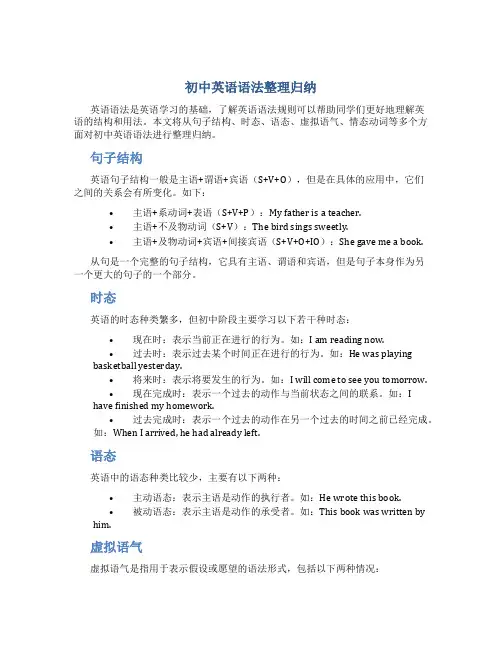
初中英语语法整理归纳英语语法是英语学习的基础,了解英语语法规则可以帮助同学们更好地理解英语的结构和用法。
本文将从句子结构、时态、语态、虚拟语气、情态动词等多个方面对初中英语语法进行整理归纳。
句子结构英语句子结构一般是主语+谓语+宾语(S+V+O),但是在具体的应用中,它们之间的关系会有所变化。
如下:•主语+系动词+表语(S+V+P):My father is a teacher.•主语+不及物动词(S+V):The bird sings sweetly.•主语+及物动词+宾语+间接宾语(S+V+O+IO):She gave me a book.从句是一个完整的句子结构,它具有主语、谓语和宾语,但是句子本身作为另一个更大的句子的一个部分。
时态英语的时态种类繁多,但初中阶段主要学习以下若干种时态:•现在时:表示当前正在进行的行为。
如:I am reading now.•过去时:表示过去某个时间正在进行的行为。
如:He was playing basketball yesterday.•将来时:表示将要发生的行为。
如:I will come to see you tomorrow.•现在完成时:表示一个过去的动作与当前状态之间的联系。
如:I have finished my homework.•过去完成时:表示一个过去的动作在另一个过去的时间之前已经完成。
如:When I arrived, he had already left.语态英语中的语态种类比较少,主要有以下两种:•主动语态:表示主语是动作的执行者。
如:He wrote this book.•被动语态:表示主语是动作的承受者。
如:This book was written by him.虚拟语气虚拟语气是指用于表示假设或愿望的语法形式,包括以下两种情况:•与现在事实相反的虚拟语气(或叫“与过去事实相反的虚拟语气”):表示与现在或过去事实相反的情况。

初中英语语法手册(整理)初中英语语法手册(整理)目录1. 词汇- 名词- 代词- 动词- 形容词- 副词2. 句子结构- 主语和谓语- 定语和状语- 宾语和补语- 从句3. 时态和语态- 一般现在时- 一般过去时- 现在进行时- 过去进行时- 将来时- 被动语态4. 其他语法知识点- 数词和量词- 介词和连词- 感叹句和祈使句- 疑问句词汇名词名词是用来表示人、事物、地方和概念的词语。
名词可分为可数名词和不可数名词两种。
代词代词用于替代名词,可以在句子中起到名词的作用。
动词动词是表示行为、状态或存在的词语。
动词可以分为及物动词和不及物动词。
形容词形容词用来描述名词的特征,可以修饰名词或代词。
副词副词是用来修饰动词、形容词、副词、或整个句子的词语。
句子结构主语和谓语主语是句子中进行动作或被动作用的人或事物。
谓语是句子中描述主语动作或状态的词语。
定语和状语定语用来修饰名词或代词,描述其特征或限定其范围。
状语修饰动词、形容词、副词或整个句子,表示时间、地点、原因、方式等。
宾语和补语宾语是及物动词的补充成分,接受动作的对象或承受动作的人或事物。
补语用来补充说明主语或宾语的状态、特征或身份。
从句从句是一个句子的一部分,可以作为名词、形容词或副词使用。
从句可以包括主语、谓语和宾语。
时态和语态一般现在时一般现在时用来描述经常发生的动作或陈述的真实情况。
一般过去时一般过去时用来描述过去某个时间发生的动作或陈述的真实情况。
现在进行时现在进行时用来描述目前正在进行或发生的动作。
过去进行时过去进行时用来描述过去某个时间正在进行的动作。
将来时将来时用来描述将来要发生的动作或事件。
被动语态被动语态用来描述动作的承受者,即主动变为被动。
其他语法知识点数词和量词数词用来表示数量,量词用来表示计量单位或数量的单位。
介词和连词介词用来表示两个词或短语之间的关系,连词用来连接句子、词或短语。
感叹句和祈使句感叹句用来表达强烈的感情或意见,祈使句用来表达命令、请求或建议。
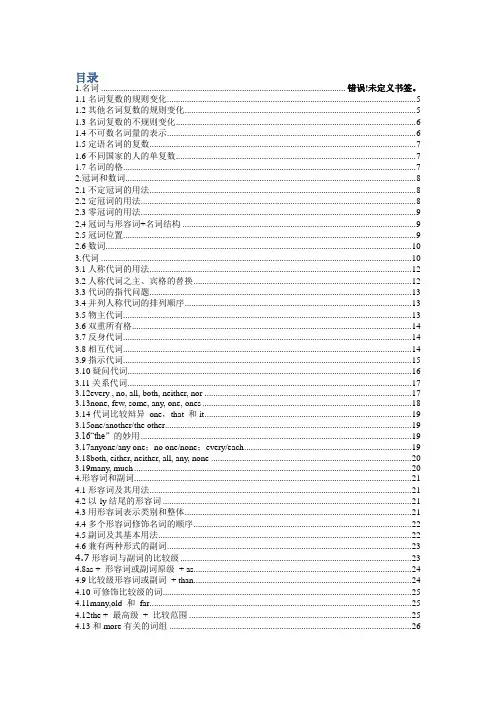
目录1.名词 ............................................................................................................... 错误!未定义书签。
1.1名词复数的规则变化 (5)1.2其他名词复数的规则变化 (5)1.3名词复数的不规则变化 (6)1.4不可数名词量的表示 (6)1.5定语名词的复数 (7)1.6不同国家的人的单复数 (7)1.7名词的格 (7)2.冠词和数词 (8)2.1不定冠词的用法 (8)2.2定冠词的用法 (8)2.3零冠词的用法 (9)2.4冠词与形容词+名词结构 (9)2.5冠词位置 (9)2.6数词 (10)3.代词 (10)3.1人称代词的用法 (12)3.2人称代词之主、宾格的替换 (12)3.3代词的指代问题 (13)3.4并列人称代词的排列顺序 (13)3.5物主代词 (13)3.6双重所有格 (14)3.7反身代词 (14)3.8相互代词 (14)3.9指示代词 (15)3.10疑问代词 (16)3.11关系代词 (17)3.12every , no, all, both, neither, nor (17)3.13none, few, some, any, one, ones (18)3.14代词比较辩异one,that 和it (19)3.15one/another/the other (19)3.16“the”的妙用 (19)3.17anyone/any one;no one/none;every/each (19)3.18both, either, neither, all, any, none (20)3.19many, much (20)4.形容词和副词 (21)4.1形容词及其用法 (21)4.2以-ly结尾的形容词 (21)4.3用形容词表示类别和整体 (21)4.4多个形容词修饰名词的顺序 (22)4.5副词及其基本用法 (22)4.6兼有两种形式的副词 (23)4.7形容词与副词的比较级 (23)4.8as + 形容词或副词原级+ as (24)4.9比较级形容词或副词+ than (24)4.10可修饰比较级的词 (25)4.11many,old 和far (25)4.12the + 最高级+ 比较范围 (25)4.13和more有关的词组 (26)5.1系动词 (27)5.2什么是助动词 (28)5.3助动词be的用法 (28)5.4助动词have的用法 (29)5.6助动词shall和will的用法 (30)5.7助动词should和would的用法 (30)5.8短语动词 (30)6.动名词 (31)6.1动名词作主语、宾语和表语 (31)7动词不定式 (32)7.1不定式作宾语 (32)7.2不定式作补语 (32)7.3不定式主语 (33)7.4It's for sb.和It's of sb. (34)7.5不定式作表语 (34)7.6不定式作定语 (34)7.7不定式作状语 (34)7.8用作介词的to (34)7.9省to 的动词不定式 (35)7.10动词不定式的否定式 (35)7.11不定式的特殊句型too...to (36)7.13不定式的特殊句型Why not (36)8.特殊词精讲 (37)8.1stop doing/to do (37)8.2forget doing/to do (37)8.3remember doing/to do (37)8.4regret doing/to do (37)8.6try doing/to do (38)8.7go on doing/to do (38)8.8be afraid doing/to do (38)8.9be interested doing/to do (38)8.10mean to doing/to do (39)8.11begin (start)doing/to do (39)8.12感官动词+ doing/to do (39)9.分词 (39)9.1分词作定语 (39)9.4分词作补语 (41)9.5分词作表语 (41)9.6分词作插入语 (41)9.7分词的时态 (41)10.独立主格 (42)10.1独立主格 (42)10.2With的复合结构 (42)11.动词的时态 (43)11.1一般现在时的用法 (43)11.3used to / be used to (44)11.4一般将来时 (44)11.5be going to / will (45)11.6be to和be going to (45)11.7一般现在时表将来 (45)11.8用现在进行时表示将来 (45)11.11用于现在完成时的句型 (46)11.12比较since和for (47)11.14延续动词与瞬间动词 (47)11.17将来完成时 (48)11.26一般现在时代替进行时 (50)11.27现在进行时代替将来时 (51)11.28时态一致 (51)1.29时态与时间状语 (51)12.动词的语态 (51)12.1Let的用法 (51)12.2短语动词的被动语态 (52)12.3表示"据说"或"相信" 的词组 (52)13.句子的种类 (53)13.1句子的种类 (54)13.4用助动词进行强调 (56)14.倒装 (58)14.1倒装句之全部倒装 (58)14.2倒装句之部分倒装 (58)14.4so, neither, nor作部分倒装 (59)14.5only在句首要倒装的情况 (59)14.6as, though 引导的倒装句 (59)14.7其他部分倒装 (60)15.主谓一致 (60)15.1并列结构作主语谓语用复数 (60)15.6与后接名词或代词保持一致 (61)16.虚拟语气 (61)16.1真是条件句 (62)16.2非真实条件句 (62)16.4虚拟条件句的倒装 (63)16.7比较if only与only if (64)16.8It is (high) time that (64)17.名词性从句 (64)17.1引导名词性从句的连接词 (65)17.2名词性that-从句 (65)17.3名词性wh-从句 (66)18.定语从句 (67)18.1关系代词引导的定语从句 (67)18.2关系副词引导的定语从句 (68)18.9关系代词that 的用法 (70)19.状语从句 (70)19.1地点状语从句 (70)19.2方式状语从句 (70)19.3原因状语从句 (71)19.4目的状语从句 (71)19.5结果状语从句 (71)19.6条件状语从句 (72)19.7让步状语从句 (72)19.8比较while, when, as (73)19.9比较until和till (73)19.10表示"一...就..."的结构 . (73)20.1并列连词与并列结构 (74)20.2比较and和or (74)20.3表示选择的并列结构 (75)20.4表示转折或对比 (75)20.5表原因关系 (75)20.6比较so和such (76)21.情态动词 (76)21.1情态动词的语法特征 (76)21.3比较may和might (76)21.4比较have to和must (77)21.5must表示推测 (77)21.6表示推测的用法 (77)21.7情态动词+ have +过去分词 (78)21.8should 和ought to (78)21.9had better表示"最好" (78)21.10would rather表示"宁愿" (79)21.14比较need和dare (80)22介词 (80)22.1介词的句法功能 (80)22.2主要介词区别 (80)1.名词名词可以分为专有名词(Proper Nouns)和普通名词(Common Nouns),专有名词是某个(些)人,地方,机构等专有的名称,如Beijing,China等。
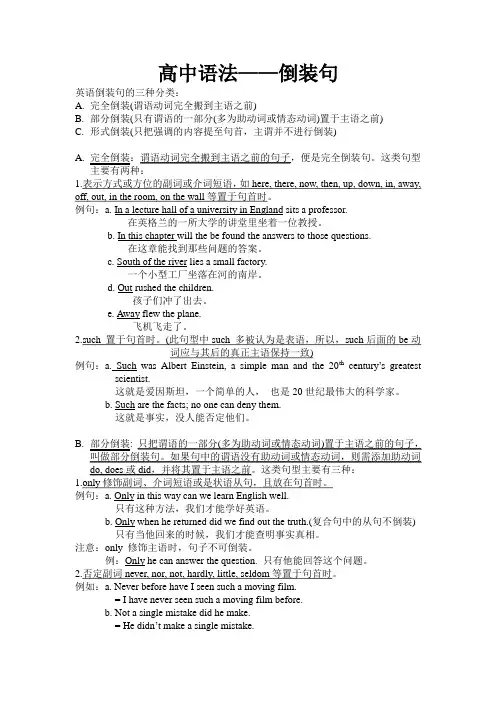
高中语法——倒装句英语倒装句的三种分类:A.完全倒装(谓语动词完全搬到主语之前)B.部分倒装(只有谓语的一部分(多为助动词或情态动词)置于主语之前)C.形式倒装(只把强调的内容提至句首,主谓并不进行倒装)A.完全倒装:谓语动词完全搬到主语之前的句子,便是完全倒装句。
这类句型1.表示方式或方位的副词或介词短语,如here, there, now, then, up, down, in, away, off, out, in the room, on the wall等置于句首时。
例句:a. In a lecture hall of a university in England sits a professor.在英格兰的一所大学的讲堂里坐着一位教授。
b. In this chapter will the be found the answers to those questions.在这章能找到那些问题的答案。
c. South of the river lies a small factory.一个小型工厂坐落在河的南岸。
d. Out rushed the children.孩子们冲了出去。
e. Away flew the plane.飞机飞走了。
2.such 置于句首时。
(此句型中such 多被认为是表语,所以,such后面的be动词应与其后的真正主语保持一致)例句:a. Such was Albert Einstein, a simple man and the 20th century’s greatest scientist.这就是爱因斯坦,一个简单的人,也是20世纪最伟大的科学家。
b. Such are the facts; no one can deny them.这就是事实,没人能否定他们。
B.部分倒装: 只把谓语的一部分(多为助动词或情态动词)置于主语之前的句子,叫做部分倒装句。
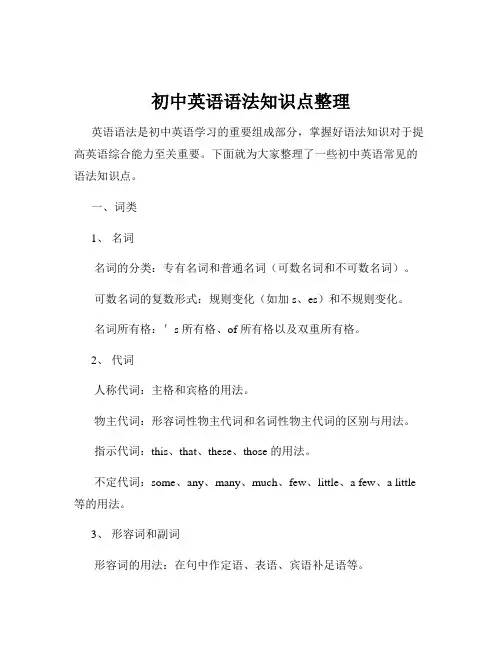
初中英语语法知识点整理英语语法是初中英语学习的重要组成部分,掌握好语法知识对于提高英语综合能力至关重要。
下面就为大家整理了一些初中英语常见的语法知识点。
一、词类1、名词名词的分类:专有名词和普通名词(可数名词和不可数名词)。
可数名词的复数形式:规则变化(如加 s、es)和不规则变化。
名词所有格:'s 所有格、of 所有格以及双重所有格。
2、代词人称代词:主格和宾格的用法。
物主代词:形容词性物主代词和名词性物主代词的区别与用法。
指示代词:this、that、these、those 的用法。
不定代词:some、any、many、much、few、little、a few、a little 等的用法。
3、形容词和副词形容词的用法:在句中作定语、表语、宾语补足语等。
形容词的比较级和最高级:规则变化和不规则变化,以及比较级和最高级的用法。
副词的用法:修饰动词、形容词、副词或整个句子。
副词的比较级和最高级:同形容词的比较级和最高级规则相似。
4、动词动词的种类:实义动词、系动词、助动词和情态动词。
动词的时态:一般现在时、一般过去时、一般将来时、现在进行时、过去进行时、现在完成时等的构成和用法。
动词的语态:主动语态和被动语态的构成和用法。
5、数词基数词和序数词的构成和用法。
分数、小数、百分数的表达。
6、介词常用介词的用法:at、in、on、for、with、by、of 等。
介词短语在句中的作用。
二、句子成分1、主语:句子所描述的人或事物。
2、谓语:说明主语的动作或状态。
3、宾语:动作的对象。
4、定语:修饰名词或代词。
5、状语:修饰动词、形容词、副词或整个句子。
6、补语:补充说明宾语或主语的性质、状态等。
三、句子类型1、陈述句:用来陈述事实或表达观点。
2、疑问句一般疑问句:用 yes 或 no 回答。
特殊疑问句:以特殊疑问词开头,如 what、where、when、why、how 等。
选择疑问句:提供两种或两种以上的选择。
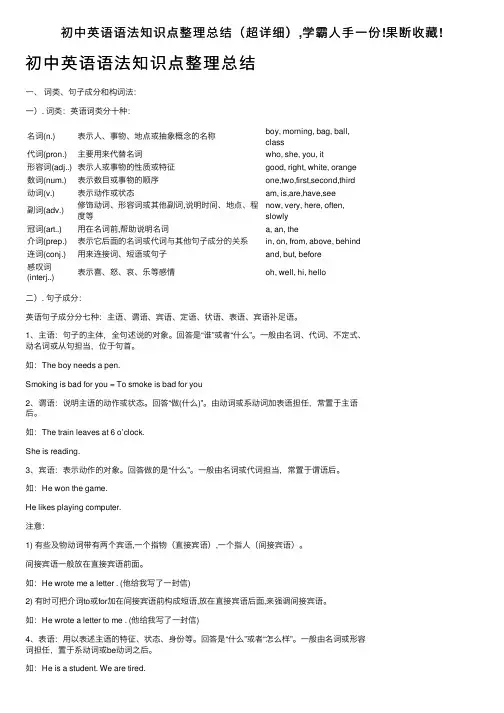
初中英语语法知识点整理总结(超详细),学霸⼈⼿⼀份!果断收藏!初中英语语法知识点整理总结⼀、词类、句⼦成分和构词法:⼀). 词类:英语词类分⼗种:名词(n.)表⽰⼈、事物、地点或抽象概念的名称boy, morning, bag, ball, class代词(pron.)主要⽤来代替名词who, she, you, it形容词(adj..)表⽰⼈或事物的性质或特征good, right, white, orange 数词(num.)表⽰数⽬或事物的顺序one,two,first,second,third 动词(v.)表⽰动作或状态am, is,are,have,see副词(adv.)修饰动词、形容词或其他副词,说明时间、地点、程度等now, very, here, often,slowly冠词(art..)⽤在名词前,帮助说明名词a, an, the介词(prep.)表⽰它后⾯的名词或代词与其他句⼦成分的关系in, on, from, above, behind 连词(conj.)⽤来连接词、短语或句⼦and, but, before感叹词(interj..)表⽰喜、怒、哀、乐等感情oh, well, hi, hello⼆). 句⼦成分:英语句⼦成分分七种:主语、谓语、宾语、定语、状语、表语、宾语补⾜语。
1、主语:句⼦的主体,全句述说的对象。
回答是“谁”或者“什么”。
⼀般由名词、代词、不定式、动名词或从句担当,位于句⾸。
如:The boy needs a pen.Smoking is bad for you = To smoke is bad for you2、谓语:说明主语的动作或状态。
回答“做(什么)”。
由动词或系动词加表语担任,常置于主语后。
如:The train leaves at 6 o’clock.She is reading.3、宾语:表⽰动作的对象。
回答做的是“什么”。
⼀般由名词或代词担当,常置于谓语后。
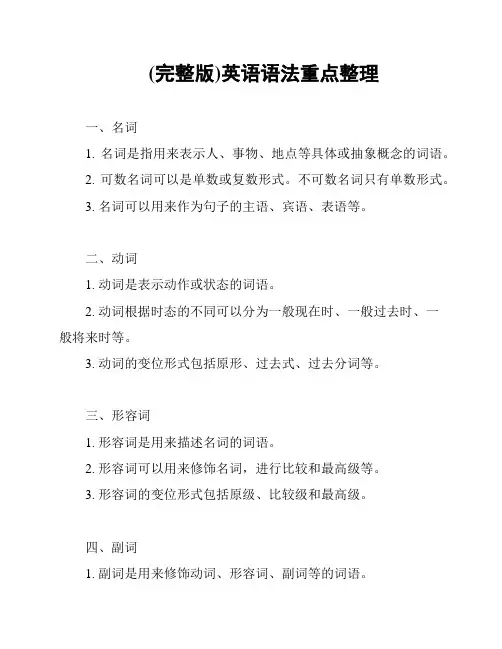
(完整版)英语语法重点整理一、名词1. 名词是指用来表示人、事物、地点等具体或抽象概念的词语。
2. 可数名词可以是单数或复数形式。
不可数名词只有单数形式。
3. 名词可以用来作为句子的主语、宾语、表语等。
二、动词1. 动词是表示动作或状态的词语。
2. 动词根据时态的不同可以分为一般现在时、一般过去时、一般将来时等。
3. 动词的变位形式包括原形、过去式、过去分词等。
三、形容词1. 形容词是用来描述名词的词语。
2. 形容词可以用来修饰名词,进行比较和最高级等。
3. 形容词的变位形式包括原级、比较级和最高级。
四、副词1. 副词是用来修饰动词、形容词、副词等的词语。
2. 副词可以用来表示时间、地点、方式、程度等。
3. 副词的变位形式一般不变。
五、介词1. 介词是用来表示两个词语之间的关系的词语。
2. 介词用来表达空间、时间、方向、原因、目的等关系。
3. 常见的介词有in, on, at, to, for等。
六、连词1. 连词是用来连接句子、短语或词语的词语。
2. 并列连词用于连接同级的词语或短语,如and, but, or等。
3. 从属连词用于引导从句,如if, because, when等。
七、冠词1. 冠词是用来限定名词的词语。
2. 冠词分为定冠词和不定冠词,如the, a, an等。
八、代词1. 代词是用来替代名词的词语。
2. 常见的代词有主格代词、宾格代词、物主代词、反身代词等。
九、句子结构1. 英语句子结构由主语、谓语、宾语等组成。
2. 句子结构可以包括简单句、复合句和并列句等。
十、语态1. 语态是用来表示动作执行者与承受者关系的词语。
2. 英语有主动语态和被动语态两种形式。
以上是英语语法的重点整理,希望对你有所帮助。
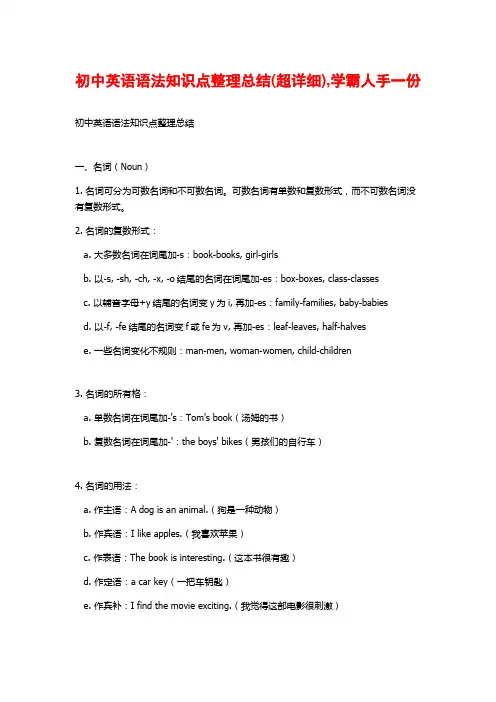
初中英语语法知识点整理总结(超详细),学霸人手一份初中英语语法知识点整理总结一、名词(Noun)1. 名词可分为可数名词和不可数名词。
可数名词有单数和复数形式,而不可数名词没有复数形式。
2. 名词的复数形式:a. 大多数名词在词尾加-s:book-books, girl-girlsb. 以-s, -sh, -ch, -x, -o结尾的名词在词尾加-es:box-boxes, class-classesc. 以辅音字母+y结尾的名词变y为i, 再加-es:family-families, baby-babiesd. 以-f, -fe结尾的名词变f或fe为v, 再加-es:leaf-leaves, half-halvese. 一些名词变化不规则:man-men, woman-women, child-children3. 名词的所有格:a. 单数名词在词尾加-'s:Tom's book(汤姆的书)b. 复数名词在词尾加-':the boys' bikes(男孩们的自行车)4. 名词的用法:a. 作主语:A dog is an animal.(狗是一种动物)b. 作宾语:I like apples.(我喜欢苹果)c. 作表语:The book is interesting.(这本书很有趣)d. 作定语:a car key(一把车钥匙)e. 作宾补:I find the movie exciting.(我觉得这部电影很刺激)二、冠词(Article)1. 不定冠词a/an:a. a用于以辅音音素(consonant phoneme)开头的词前:a book(一本书)b. an用于以元音音素(vowel phoneme)开头的词前:an apple(一个苹果)2. 定冠词the:a. 用于特指某一事物或人:the book(这本书)b. 用于上文已提及的事物或人:There is a book. The book is interesting.(这里有一本书。
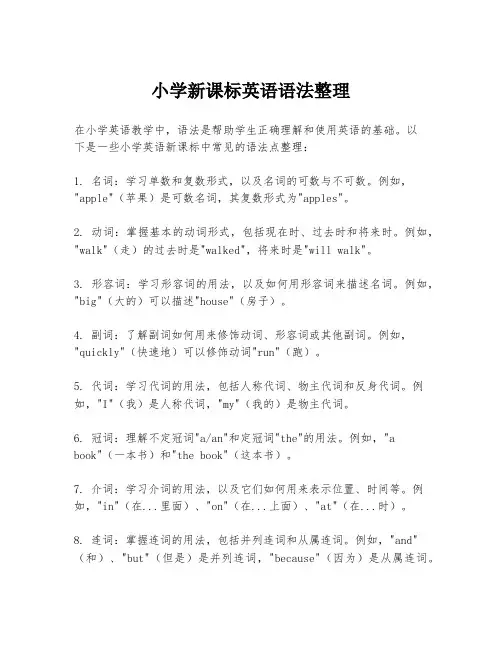
小学新课标英语语法整理在小学英语教学中,语法是帮助学生正确理解和使用英语的基础。
以下是一些小学英语新课标中常见的语法点整理:1. 名词:学习单数和复数形式,以及名词的可数与不可数。
例如,"apple"(苹果)是可数名词,其复数形式为"apples"。
2. 动词:掌握基本的动词形式,包括现在时、过去时和将来时。
例如,"walk"(走)的过去时是"walked",将来时是"will walk"。
3. 形容词:学习形容词的用法,以及如何用形容词来描述名词。
例如,"big"(大的)可以描述"house"(房子)。
4. 副词:了解副词如何用来修饰动词、形容词或其他副词。
例如,"quickly"(快速地)可以修饰动词"run"(跑)。
5. 代词:学习代词的用法,包括人称代词、物主代词和反身代词。
例如,"I"(我)是人称代词,"my"(我的)是物主代词。
6. 冠词:理解不定冠词"a/an"和定冠词"the"的用法。
例如,"a book"(一本书)和"the book"(这本书)。
7. 介词:学习介词的用法,以及它们如何用来表示位置、时间等。
例如,"in"(在...里面)、"on"(在...上面)、"at"(在...时)。
8. 连词:掌握连词的用法,包括并列连词和从属连词。
例如,"and"(和)、"but"(但是)是并列连词,"because"(因为)是从属连词。
9. 数词:学习基本的数词,包括基数词和序数词。
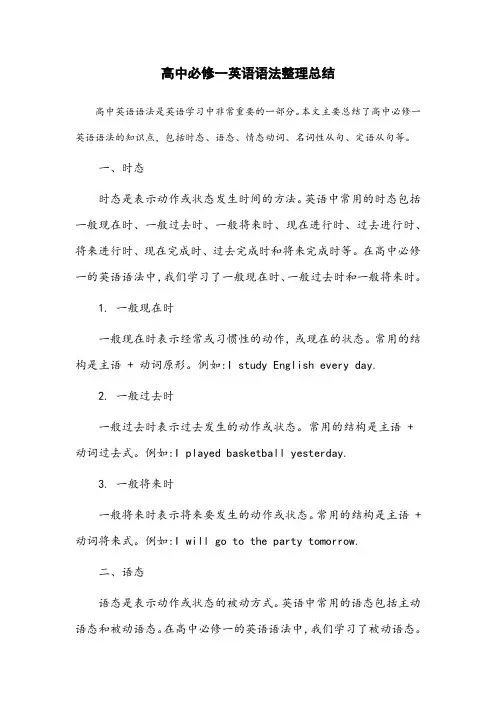
高中必修一英语语法整理总结高中英语语法是英语学习中非常重要的一部分。
本文主要总结了高中必修一英语语法的知识点,包括时态、语态、情态动词、名词性从句、定语从句等。
一、时态时态是表示动作或状态发生时间的方法。
英语中常用的时态包括一般现在时、一般过去时、一般将来时、现在进行时、过去进行时、将来进行时、现在完成时、过去完成时和将来完成时等。
在高中必修一的英语语法中,我们学习了一般现在时、一般过去时和一般将来时。
1. 一般现在时一般现在时表示经常或习惯性的动作,或现在的状态。
常用的结构是主语 + 动词原形。
例如:I study English every day.2. 一般过去时一般过去时表示过去发生的动作或状态。
常用的结构是主语 + 动词过去式。
例如:I played basketball yesterday.3. 一般将来时一般将来时表示将来要发生的动作或状态。
常用的结构是主语 + 动词将来式。
例如:I will go to the party tomorrow.二、语态语态是表示动作或状态的被动方式。
英语中常用的语态包括主动语态和被动语态。
在高中必修一的英语语法中,我们学习了被动语态。
1. 被动语态被动语态表示主语是动作的承受者。
常用的结构是 be + 过去分词。
例如:The book was read by the teacher.三、情态动词情态动词是表示能力、可能性或义务的动词。
英语中常用的情态动词包括 can、may、must、should、will 等。
在高中必修一的英语语法中,我们学习了情态动词的用法和意义。
1. cancan 表示能力或允许。
例如:I can speak English.2. maymay 表示可能性或允许。
例如:You may come to my party.3. mustmust 表示肯定或义务。
例如:He must study hard.4. shouldshould 表示应该或义务。
高中高一英语语法必背知识点总结梳理语法是从阅读学来的.语法书必然有用,但它和字典一样,只是从旁辅助的工具.只看语法书却从不阅读,一定会走火入魔,其下场与死背生词相同.下面是小编为大家整理的有关高一英语语法必背知识点总结,希望对你们有帮助!高一英语语法必背知识点总结专题一:定语从句1.that指人或物在从句中作主语,宾语或表语which指物在从句中作主语,宾语或表语(作宾语时可以省略)who指人在从句中作主语,宾语或表语whom指人在从句中作宾语whose指人或物在从句中作定语as指人或物在从句中作主语,宾语或表语but指人或物在从句中作主语,宾语或表语注意:指物时,whose+名词=the+名词+ofwhich或ofwhich+the+名词2.as的用法(1)常用于下列结构:such…as;so…as;thesame…as;as…as注意:thesame…as表示同一类,不同一个thesame…that表示同一个(2)as与which的区别a.位置不同as可放在主句后,主句前或主句中间;which只能放在主句后.b.as起连接作用,表达说话人的观点.看法,并指出主句内容的根据或出处,意为〝正如,正像〞.Which相当于并列句,可以用andthis来代替,意为〝这一点,这件事’〞.注意:as常用于下列结构:asweknow/asisknowntoall,asweallcansee,ashasbeensaidbefore/above, asmightbee_cepted,asisoftenthecase,一般不能用which代替as.c.在从句中作主语时,which既可作系动词be的主语也可作实义动词的主语,而as只可作系动词be的主语.二.只用that不用which的情况1..先行词为all,much,everything,nothing,something,anything,nothing,none,theone等不定代词时2.先行词被only,any,few,little,no,all,just,very,right等修饰时.3.当先行词是最高级或被形容词最高级修饰时.4.当先行词是序数词或被序数词修饰时.5.当先行词是数词时.6.当先行词既指人又指物时.7.如有两个定语从句,其中一个关系代词已用which,另一个关系代词则宜用that.8.主句是Therebe结构,修饰其主语的定语从句宜用that作关系代词.9.被修饰成分为表语,或者关系代词本身是定语从句的表语时,该关系代词宜用that._.先行词为what,关系代词用that._.有时为了避免重复而使用that引导定语从句.三.只用which不用that的情况1.当介词放在关系代词之前时.2.在非限制性定语从句中.3.当关系代词指整个主句的概念时.四.只用who不用that的情况1.当先行词是one,ones,anyone或those时.2.therebe结构中.3.当先行词是人,后面有较长修饰语时.4.为了避免重复或引起歧义.5.当先行词是I,you,he,they等时(常用于谚语中).6.先行词是指成员的集体名词.7.who可以引导非限制性定语从句.8.先行词是拟人化的名词.9.先行词指特定的人时用who,不指特定的人用that.五.关系副词引导的定语从句1.when时间状语注意:It/Ihis/That+be+thefirst/second/lasttimethat…只能用that,that 可以省略,从句用相应的完成时.2.where地点状语注意:当先行词为模糊的地点时,如point.Situation,case,position,stage,scene,spot,activity,family,job等名词时用where.3.why原因状语先行词为reason.六.介词与关系代词1.介词如何确定(1)依据定语从句中动词的习惯搭配来确定(2)依据先行词的习惯搭配来确定(3)根据意思来确定(4)为了强调某一名词,不定式前加上关系词2.关系代词作介词的宾语时,介词的位置(1)whom和which可以和介词一起放在先行词和从句之间,也可以把介词放在从句中有关动词的后面.(2)含有介词的短语动词一般不拆开,介词仍放在动词的后面.(3)关系代词that在从句中作介词宾语时,介词不能放在它的前面,只能放在从句中有关动词的后面.(4)关系代词whose也可以在从句中与它所修饰的名词一起作介词宾语.3.〝名词/数词/代词+介词+关系代词〞结构常见的形式有:名词/one/two/some/none/all/both/several/many/most/afew/alittle/the+比较级/the+最高级…+of+which/whom.七.定语从句中的主谓一致1.关系代词作从句的主语时,从句中谓语动词的人称和数要与先行词保持一致,先行词是句子时,从句的谓语动词用单数形式.2.〝oneof+复数名词〞位于关系代词前作先行词时,关系代词在从句中作主语,从句的动词通常用复数,但当one前有the,theonly,thevery等修饰时,从句的谓语动词要用单数.八.注意way和time后接定语从句的情况1.当先行词是way,且意为〝方式.方法〞时,引导定语从句的关系词有下列三种形式:that/inwhich/不填.注意:关系词在从句中必须作状语.如果关系词在从句中作主语或宾语,按正常的定语从句分析.2.当先行词是time时,若time作〝次数〞讲,应用that引导定语从句,that 可省略;若time作〝一段时间〞讲,应用关系副词when或介词at/during+which 引导定语从句.专题二:状语从句一.时间状语从句1.when的用法(1)when既可引导一个持续性动作,也可引导一个短暂性动作,可用于表示主句和从句动作同时发生或从句动作先于主句动作,有时还可表示从句动作后于主句,意为〝当...时候〞.(2)when在beabouttodo...when...,bedoing....when...,haddone...when...,beonone’sway....when....,beonthepointofdoing.....when......等结构中,作〝那时突然〞讲.(3)when〝既然.鉴于;尽管,虽然(位于主句之后);如果〞2.while的用法(1)表示〝当...时候〞,引导的动作必须是延续性的(2)用作并列连词,表示相对关系〝然而〞(3)引导让步状语从句,相当于although,意为〝虽然〞,位于主句前.(4)引导条件状语从句,相当于as/solongas,意为〝只要〞3.as的用法(1)表示〝当...时候〞,强调同时发生,不指先后(2)说明两种正在发展或变化的情况,表示〝随着〞,表示时间的推移.(3)表示〝一边...一边...〞(4)强调两个动作紧接着发生.(5)表示〝虽然,尽管〞.(6)其他含义〝正如,正像〞,〝作为〞,〝由于,因为〞4.before的用法(1)一般意为〝在....之前〞〝....才〞,〝....就〞〝还没有...〞〝免得〞〝不知不觉〞〝宁可,宁愿〞,〝否则,要不然〞.(2)It+willbe/was+时间段+before+一般现在时/一般过去时.在肯定句中,意为〝多长时间之后才〞;在否定句中,意为〝用不了多长时间就〞.5.until和till(1)与肯定句连用,必须是延续性动词.(2)与否定句连用,必须是非延续性动词,表示〝直到...才,在....之前不...〞.注意:notuntil可用于强调句和倒装句强调句:Itis/wasnotuntil…that…倒装句:notuntil放句首时,主句要部分倒装.6.since的用法(1)since后是非延续性动词,时间起点从该动作发生算起,意为〝做某事多久了〞;since后是延续性动词,时间起点从该动作结束算起,意为〝不做某事已有多长时间〞.(2)Itis/hasbeen+时间段+since+一般过去时7.表示〝一......就......〞的句型(1)assoonas,once,immediately,directly,instantly,themoment,theminute 等引导的从句都表示从句的动作一发生,主句的动作随即发生,常译作〝一...就....〞,这类从句中,经常用一般现在时态代替将来时态.(2)ondoingsth.或〝onone’s+名词〞作时间状语.8.有些名词和副词可以起连接词的作用,引导时间状语从句.注意:时间状语从句中不用将来时态.若要表示将来时间,可用一般现在时态表示.但when引导名词性从句时,从句中要使用将来时.二.地点状语从句1.地点状语从句由where,wherever引导.注意:where与where的区别:Where表特定的地点,而wherever表示非特定的地点.Wherever=to/atanyplacewhere2.地点状语从句与定语从句的区别Where引导定语从句时,从句前应有一个表示地点的名词作先行词;而状语从句前则无先行词.三.原因状语从句引导词:because,since,as,nowthat,notthat…,butthat…,seeingthat,considerin gthat,inthat注意:for也可以表示原因,属并列连词,但不是说明直接原因,而是对某种情况加以推断,用于表示补充说明理由.四.目的状语从句引导词:so,sothat,inorderthat,that,totheendthat(以便,为了),incase,forfearthat,lest(以免,以防),目的状语从句中通常有情态动词can,could,may,might,should,would等. 注意:1.incase还可表示〝万一,假如〞.2.目的状语从句可以用soasto,inorderto等不定式代替,但主句和从句的主语必须一致.五.结果状语从句引导词:so...that(如此...以至于....),such...that(如此...以至于...),sothat(结果是),withtheresultthat(所以,结果是)注意:(1)so...that与such...that的区别So+形容词such+a/an+形容词+单数名词So+形容词+a/an+单数名词such+形容词+复数名词So+副词such+形容词+不可数名词Somany/few+复数名词Somuch/little+不可数名词(2)sothat引导的目的状语从句与sothat引导的结果状语从句目的状语从句一般使用情态动词,结果状语从句一般不使用情态动词;结果状语从句常常用逗号与主句分开.(3)so...that与so...as;such...that与such...asSo...that/such...that为结果状语从句;so...as/such...as为定语从句.六.条件状语从句引导词:if(如果),unless(除非),ifonly(只要,但愿),onlyif(只有),incase(万一),suppose/supposing(that)(假设),provided/providing(that)(只要,假若),onconditionthat(要是,在...条件下),so/aslongas(只要),(let s/letus)say(假设)七.方式状语从句引导词:as(像...一样,正如....),asif/asthough(好像,宛如)注意:1.固定句型AistoBwhatCistoD.意为〝A对B而言正如C对D一样〞.2.asif,asthough引导的从句若与事实相反,用虚拟语气;若与事实相符,不用虚拟语气.八.让步状语从句引导词:though/although/as(虽然,尽管),evenif/though(即使,尽管),whether/nomatterwhether...or(not)(不管...是否,不管是....还是)wh-ever/nomatterwh-(无论...)注意:(1)though,although,as的区别A.Though,although的主句中可以用yet,still,nevertheless,但不可使用but.B.though引导的从句可以倒装,也可以不倒装;as引导的从句必须倒装;although引导的从句不能倒装.其结构为:形容词/分词/副词/动词原形/名词(无冠词)+as/though+主语+谓语……(2)though可用作副词,放在句末,意为〝不过,但是〞.Although无此用法.(3)某些短语也引导让步的从句或短语,意为〝尽管〞,如:inspiteofthefactthat,despitethefactthat,regardlessof(thefactthat) 九.比较状语从句引导词:as...as(和...一样),notas/so...as(和...不一样),than(比),themore...themore...(越...越...)十.状语从句中的省略问题1.在状语从句中如果主语与主句的主语一致,同时从句中又含有系动词be,则通常可省去从句的主语和系动词be,留下其余部分.2.若状语从句中主语是it,动词是系动词be,则通常可省去主语it及系动词be,留下其余部分.专题三:名词性从句一.that从句1.主语从句(1)that从句作主语时,常用it作形式主语,常见的句型有:It+be+形容词(obvious,true,natural,surprising,good,wonderful,funny,possible,likely ,certain,probable,etc.)+that从句It+be+名词词组(nowonder,anhonor,agoodthing,apity,nosurprise,etc.)+that从句It+be+过去分词(said,reported,thought,e_pected,decided,announced,arranged,etc.)+that 从句(2)that可以省略,但that从句位于句首时,that不能省略.2.宾语从句(1)常见的可以接that从句作宾语的动词有see,say,know,imagine,discover,believe,tell,show,think,consider,besure ,beafraid等.在可以接复合宾语的动词之后,如think,make,consider等,可以用it作形式宾语.(2)That从句一般不能充当介词宾语,偶尔可作e_cept,in的宾语.3.表语从句(that不可省略)4.同位语从句连词that引导同位语从句时,应在某些抽象名词之后,如:fact,hope,desire,thought,suggestion,idea,news,problem,possibility 等,对前面的名词起补充说明的作用,that在从句中不担当任何成分,不能省略.二.whether/if从句1.在表语从句和同位语从句中只能用whether不能用if;当主语从句放于句首时,只能用whether不用if;当it作形式主语,主语从句放在句末时用whether 或if均可;discuss后引导宾语从句时,必须用whether.2.在宾语从句中:(1)及物动词后:whether从句中不能有否定式,宾语从句为否定句时用if;if 不能与ornot连用,但可以用whetherornot;whether后可以加不定式.(2)介词后:只能用whether,不用if.三.特殊疑问词引导的从句1.主语从句:特殊疑问词引导主语从句时,常用it作形式主语.2.宾语从句(1)常见的能接特殊疑问词引导的宾语从句的动词有see,tell,ask,answer,know,decide,findout,imagine,suggest,doubt,wonder, show,discuss,understand,inform,advise等.(2)作介词宾语.3.同位语从句.表语从句四.名词性关系从句What=thething(s)which/thatwhoever=anyonewhowhichever=anyone/anythingthatwhatever=anythingthatwhere=theplacewherewhen=thetimewhen五.名词性从句的几个难点(一)that不可省略的情况1.主语从句,that从句置于句首时;2.当一个句子有两个或多个并列的宾语从句时,引导第二和以后几个从句的that不可省略;3.由it作形式宾语时,that引导的宾语从句中,that不可以省略.(二)wh-ever与nomatterwh-的用法区别Wh-ever既可引导名词性从句,又可引导让步状语从句;而nomatterwh-只能引导让步状语从句.(三)asif/though,because,why可以引导表语从句注意:because引导的表语从句,主语不能是reason或cause,而且since,as 不能引导表语从句.(四)that引导的同位语从句与关系代词that引导的定语从句的区别That引导的同位语从句成分是完整的,that在从句中不担当任何成分;that引导的定语从句成分是残缺的,that在从句中充当主语.宾语或表语.专题四:动词的时态和语态一.一般现在时1.表示经常发生的习惯性的.现在反复出现的动作或状态,常用的时间状语有:always,usually,seldom,sometimes,everyday,nowandthen,onceaweek等.2.表示眼下或目前等现在时间所发生的动作或存在的状态,这种状态带有一定的持续性.3.表示客观事实或普遍真理.4.书报的标题,故事的叙述,小说.戏剧.电影等情节介绍,图片的说明等.5.时间表.时刻表.日程表.节目单.课程表等按规定将要发生的动作,只限于go,arrive,leave,start,stay,return,begin,come等动词.6.在时间.条件.方式.让步状语从句中,表示将来的动作.注意:一般现在时可以用于定语从句或宾语从句中表示将来.7.用在某些表达中,表示现在正在发生的动作或存在的状态.Herecomesthebus!Howitrains!二.一般过去时1.表示在过去某一时间点发生的动作或所处的状态,与现在没有关系.常用的时间状语有:yesterday,lastnight,atthattime等.2.表示在过去某一段时间里反复出现的动作或状态,与现在没有关系.3.用usedtodo或woulddo表示过去经常或反复发生的动作.4.有些情况发生的时间没清楚表明,但实际上是〝刚才,刚刚〞发生的,属于过去时间,应使用过去时态.常见的有Ididn’tknow…或Iforgot…等.5.一般过去时可与today,thisweek,thismonth等时间状语连用.三.一般将来时1.will/shalldo(1)表示将来会出现的动作或状态.常用的时间状语:thisevening,tomorrow,ne_tweek/month…,attheendofthisterm,inafewmin utes等.(2)表示将来经常发生的动作.(3)表示事物的固有属性或必然趋势.倾向.(4)表示说话过程中做出某种决定.注意:条件状语从句中的will表示〝决心,意愿〞,此时will是情态动词表示意愿.2.begoingtodo(1)表示已经决定或安排要做的事.(2)表示根据某种迹象认为在最近或将来将要发生的事.3.betodo(1)表示约定.计划或按职责.义务要求即将发生的动作.(2)表示说话人的意志.意图.职责.义务.命令.(3)表示注定要发生的事情.4.beabouttodo(1)表示即将发生的动作,意为〝正要,即将〞.(2)不可与表示具体的将来时间的副词或副词性短语连用,但可以同由as或when引导的时间状语从句连用.5.某些动词的现在进行时表示即将发生的动作.四.过去将来时1.would/shoulddo表示从过去某一时间来看将要发生的动作或将要存在的状态.通常用于其主句的谓语为过去时态的宾语从句中.2.were/wastodo表示过去将来时间的安排,如果这个安排后来被取消,没有实现,则用was/weretohavedone表示.五.现在进行时1.表示说话时正在进行而尚未完成的动作或状态.2.表示现阶段一直在进行的动作,但说话时不一定正在进行.3.有时可表示即将发生的动作(只限于go,come,stay,leave,start,begin,arrive,return,fly,drive等动词),这时常有一个表示将来时间的状语.4.常与always,forever,constantly,continually,allthetime等时间副词连用,表示反复发生的或习惯性的动作,常表示不满.抱怨或赞赏等情感.5.有些表示感觉.情感的动词不能用进行时,它们是:know,understand,love,like,hate,feel,desire,wish,want,refuse,rememb er,hear,see,have等,这些动词一般不用进行时,通常用一般现在时态,表示说话时发生的动作.六.过去进行时1.表示过去某一时刻或某一时间内正在进行的动作.这一特定的过去时间通常有时间状语(从句)或由上下文来表示.2.表示过去某一阶段一直在进行的动作.但说话时不一定正在进行.3.表示从过去某一时间的角度看将要发生的动作,用于某些动词.(见现在进行时3)4.与always,frequently等副词连用,表示感情色彩.七.将来进行时1.表示在将来某一时刻或某一时间段正在进行的动作.2.表示根据计划或安排在将来某一时刻正在进行的动作.此时一般有具体的时间状语.3.表示将来某一时刻自然发生的事,而不是人为安排要做的事.4.表示有礼貌地询问对方的打算,语气比较委婉.八.现在完成时1.表示过去发生的某一动作对现在造成的影响或结果.常用的状语有already,yet,just等.2.表示过去已经开始,持续到现在,而且还可能继续下去的动作状态.往往和表示一段时间的状语连用,如today,thisweek,lately,recently,inthepastfewdays,since,foralongtime 等.注意:(1)非延续性动词在肯定句中不能与表示一段时间的时间状语连用.(2)此类动词在否定句中则可以与表示一段时间的时间状语连用.这类动词有:begin,leave,go,borrow,come,return,born,die,buy,arrive.3.在时间或条件状语从句中,现在完成时代替将来完成时,表示将来某个时刻之前已经完成的动作.4.现在完成时和一般过去时的区别现在完成时:表示某一已完成的动作对现在造成的影响或结果,强调的是现在的情况,不能喝表示过去的时间状语连用.一般过去时:只单纯表示过去的动作或状态,和现在不发生联系.它可以和表示过去的时间状语连用.九.现在完成进行时1.表示从过去某时开始一直延续到现在的动作,可能刚刚停止,也可能还在继续进行.2.重复的动作表示感情色彩.表示一直到说话时为止的一段时间内一再重复的动作.3.现在完成时和现在完成进行时的区别(1)表示动作已完成,着重结果;现在完成进行时表示动作的进行,强调动作的持续性.(2)状态动词.知觉动词或情态动词如:see,feel,know,love等,不用于现在完成进行时,但可用于现在完成时.十.过去完成时1.表示在过去某一时刻或动作以前已经完成了的动作,即〝过去的过去〞.注意:在含有时间状语从句的复合句中,若两个动作紧接着发生,则不需用过去完成时,尤其是在含有before和after的复合句中,常用一般过去时代替过去完成时.2.表示未曾实现的希望.打算.意图.诺言等.常用hadhoped/planned/meant/intended/thought/wanted/e_pected等或用上述动词过去式接不定式表示即:hoped/planned…+todo.3.过去完成时用于hardly…when,nosooner…than等固定句型中.十一.不能用被动语态的情况1.therebe结构及所有的不及物动词或词组充当谓语时,无被动语态.2.系动词无被动语态.3.一些表示状态的及物动词,如cost,have,own,possess等不能用被动语态.4.表示〝希望.意图〞的动词,如wish,want,hope,like,love,hate等不能变被动语态.5.当及物动词leave,enter,reach等的宾语是表示地点和处十二.主动形式表被动意义1.某些动词形式上主动,但含有被动意思,往往表示主语本身的性质,而且主语应该是事物.2.在〝have+宾语+todo〞结构中,当不定式的逻辑主语在句中出现时,不定式用主动语态,否则用被动语态.3.在〝be+形容词+todo〞中,不定式的逻辑宾语是句子的主语,用主动表被动.4.在某些词组中,用动词的主动形式表被动.(1)beworthdoing(2)want,require,need后面的动名词用主动形式表示被动含义.(3)with复合结构十三.被动形式表示主动意义的几种情况beseated(坐着),behidden(躲藏),belost(迷路),bedrunk(喝醉),bedressed(穿着)专题五:情态动词一.can和could1.can的用法(1)表示体力和脑力方面的能力.(2)表示对现在的动作或状态进行主观的猜测,主要用在否定句和疑问句中.(3)表示可能性,理论上的可能性,意为〝有时候可能会〞,可用于肯定句.(4)表示允许,意思与may接近.(5)表示说话人的推测.怀疑.惊异.猜测或不肯定等,主要用于否定句.疑问句或感叹句中.(6)can的特殊句型cannot…too/enough表示〝无论怎么...也不过分〞〝越...越好〞cannotbut+dosth.表示〝不得不,只好〞2.could的用法(1)表示能力,指的是过去时间.(2)表示允许,指的是过去时间.(3)表示可能,可以指过去时间,也可以指现在时间,表示语气缓和.(4)委婉客气地提出问题或陈述看法,指的是现在时间.主要用于疑问句,回答时用can.3.can与could的区别can表推测时只用于否定句和疑问句(could无此限制).couldn’t的可能性比can’t小.4.can与beableto的区别(1)现在时:无区别,但后者不常用.(2)完成时;can没有完成时,此时要用have(has,had)beenableto.(3)将来时:can没有将来时,要用willbeableto.(4)过去时:could表示一般能力,was/wereableto表示在具体场合通过努力成功做成某事的能力.二.may和might1.may的用法(1)表示询问或说明一件事可不可以做.(2)表示一件事或许会发生或某种情况可能会存在,通常用在肯定句和否定句中.注意:表示可能性时,can’t语气强,表示〝不可能〞,maynot语气弱,表示〝可能不〞.2.might的用法(1)表示询问或允许,指的是过去时间.(2)表示可能发生的事,可以指过去时间,也可以指现在时间,语气更加不肯定,可能性比may小一些.3.may与might的特殊用法(1)〝may+主语+动词原形〞表示祝愿.(2)〝may/mightwell+动词原形〞表示(完全)能,很可能.(3)〝may/mightaswell+动词原形〞表示最好,满可以,倒不如.(4)maybe是〝情态动词+系动词be〞结构,表示〝可能有,可能在〞,否定式为maynotbe.maybe是一个词,为副词,意为〝大概,或许,可能〞,在句中作状语.三.must的用法1.表示〝必须〞,多强调说话人的主观看法.2.must和haveto的区别:(1)must表示说话人的义务或说话人主观认为〝必须,应当〞做某事;haveto 表示由于某种外界原因而〝必须,不得不〞做某事.即must侧重说明主观看法,haveto强调客观需要.(2)must只有一种形式,可用于现在.过去或将来时,但haveto有不同的形式,可用于不同的时态.(3)在否定句中,don’tneedto,don’thaveto,needn’t表示没有义务;mustn’t表示禁止.3.must的否定形式mustnot/mustn’t意为〝不许,禁止〞,表示绝对禁止.若表示〝没必要,不必〞,应使用needn’t或don’thaveto.注意:对must作否定回答时,不用mustn’t,用needn’t或don’thaveto.4.must表示〝偏偏〞,指令人不快的事情.5.must用来表示推测,意为i〝准是,肯定是〞,一般用于肯定句,肯定程度比may,might大的多.四.need的用法1.need用作情态动词,后面接动词原形,通常用在否定句和疑问句中.2.回答need时,肯定回答用must,否定回答用needn’t或don’thaveto.3.need用作实义动词时,有时态.人称和数的变化,后面加todo.4.needtodo和needdoingneedtodo中不定式的逻辑主语就是主句的主语;needdoing是主动形式表示被动含义,即need前的主语就是need后面的动词所表示的动作的承受者.注意:want和require作〝需要〞讲时,和need的用法相同.5.needn’thavedone与didn’tneedtodoneedn’thavedone表示过去本不必做但实际上却做了某事didn’tneedtodo表示过去不必做而实际上也没做某事五.dare的用法1.dare用作情态动词,后面接动词原形,通常用在否定句和疑问句和条件句中;它没有人称和数的变化,但有过去式(dared).2.dare用作实义动词时,有时态.人称和数的变化,后面加todo.注意:(1)Idaresay意为〝我认为,我相信,很可能〞.(2)dare用作实义动词时,表示〝敢冒(危险),不俱〞.(3)dare可用于激将或挑战.例:Hedaredmetojumpdown.六.will和would1.will的用法(1)可以表示主观意志.意愿,可用于各种人称.(2)可以表示经常性.习惯性.倾向性等,意为〝经常,惯于,总是〞.(3)表示命令(说话这确信命令一定会得到执行)或允诺.(4)will可用于祈使句的附加疑问句.(5)用于疑问句,表〝邀请,请求〞,常与第二人称you连用.2.would的用法(1)作为will的过去时态,用于过去时中,表示主观愿望或意志,意为〝愿意,执意〞.(2)用与第二人称,表示谦恭的请求或征求意见,比will更为客气.(3)表示过去的习惯,后接动词原形,意为〝总是,总会〞.(4)would表意愿用于词组中.Wouldlike〝喜欢,想要〞(=wouldlove)Wouldrather〝宁愿〞七.shall和should1.shall的用法(1)shall用于第一.三人称陈述句中,表示说话人征求对方的意见或向对方请示.(2)shall用于第二.第三人称陈述句中,表示说话人给对方的命令.警告.允诺或威胁.(3)用于所有人称,表示规章.法令.预言等,可译为〝必须〞.2.should的用法(1)表示义务.责任或劝告.建议.命令等,意为〝应该〞.(2)表示有一定根据的推测.推论或可能性,意为〝可能,该〞(肯定的语气没有must表推测时强).(3)多用于疑问句中,表示惊讶.难以相信或不应该的事.(4)oughtto和should的比较A.oughtto也可以表示推论.可能性,和should用法一样.B.在省略回答中,oughtto中的to可以省略.C.should和oughtto表示做正确的事情或理应做的事情.besupposedto意为〝被期望,应该〞,表示被期望发生或根据安排.要求做某事,或认为做某事是正常的.八.hadbetter意为〝最好〞,’dbetter为其缩写形式,其后续跟动词原形. 注意:hadbetter的否定形式hadbetternot.九.usedto〝过去常常〞,仅用于过去时态中,通常用于所有人称.。
初中英语语法知识点整理总结1.一般现在时一般现在时用来表示经常性的动作、事实或客观真理。
主语为第三人称单数时,动词要加s或es。
2.一般过去时一般过去时用来表示过去发生的事件或状态。
动词过去式有规则动词和不规则动词之分。
3.现在进行时现在进行时表示现在正在进行的动作,动词的变形为:am/is/are + 动词-ing。
4.现在完成时现在完成时表示过去发生的动作对现在造成的影响或结果。
动词的变形为:have/has + 过去分词。
5.一般将来时一般将来时用来表示将来发生的动作或存在的状态。
动词的变形为:will + 动词原形。
6.一般过去将来时一般过去将来时用来表示过去一些时间点之后本该发生但未发生的动作或情况。
动词的变形为:would + 动词原形。
7.动词不定式动词不定式用来表示一种动作或状态,或用作名词、定语或状语。
一般情况下,不定式前要加to。
8.动词的时态和语态英语动词的时态主要有三个:一般时、进行时和完成时。
动词的语态有两个:主动语态和被动语态。
9.定冠词和不定冠词定冠词the用来特指一些人或物,不定冠词a/an用来泛指一个人或物。
10.物主代词物主代词用来表示所有关系,如my, your, his, her, its, our, their等。
11.可数名词和不可数名词可数名词有单数和复数之分,不可数名词只有单数形式。
12.复数名词的变化规则复数名词一般在词尾加-s,以s,x,sh,ch结尾的名词在词尾加-es,以辅音字母+y结尾的名词变y为i再加-es。
13.形容词比较级和最高级形容词比较级用于比较两者,最高级用于比较三者或以上的事物。
14.形容词和副词的用法形容词修饰名词,副词修饰动词、形容词和副词。
15.介词的用法介词用于连接名词或代词与其他词,表示时间、地点、方向、原因等关系。
16.物主形容词和物主代词物主形容词用于修饰名词,物主代词用于代替名词。
17.反身代词反身代词用于强调一个人或物是动作的承受者或产生者。
七年级英语语法知识点归纳整理对初中学生的指导更多的应侧重于学习方法和学习意志品质的培养进入初中以后,学生在学习上的独立性逐步增强。
课堂教学中,教师比较注意启发学生独立思考问题;课堂教学外,学生更多的需要自觉地独立安排自己的学习活动。
接下来是小编为大家整理的七年级英语语法知识点归纳整理,希望大家喜欢!七年级英语语法知识点归纳整理一【重点句子】1.How many colours do you see? 你能看见多少种颜色?how many+可数名词复数, 含有how many的特殊疑问句,要用数词来回答。
如:—How many markers do you have? 你有多少枝水彩笔? —I have ten. 我有十枝。
/----Just one. 只有一个。
2. My skirt is very old. Can I get a new one? 我的裙子很旧了,我能买一条新的吗?one在这里是代词,代替前面的skirt.英语中,为了避免重复,常用one代替上文中已出现过的同一类人或物。
Eg: I have a nice sweater. Do you want one? 我有一件漂亮的毛衣。
你想要一件吗?3. What’s your favourite colour? 你最喜欢的颜色是什么?What’s your favourite…?是询问“你最喜欢的??是什么?”的交际用语,其答语是:My favourite ....is…如:---What are your favourite clothes? 你最喜欢的衣服是什么?---My favourite clothes are blouse and skirts. 我最喜欢的衣服是衬衫和连衣裙。
—What’s your favourite sport? 你最喜欢的运动是什么?—My favourite sport is Ping-pong. 我最喜欢的运动是乒乓球。
1.名词名词复数的规则变化其他名词复数的规则变化名词复数的不规则变化不可数名词量的表示定语名词的复数不同国家的人的单复数名词的格2.冠词和数词不定冠词的用法定冠词的用法零冠词的用法冠词与形容词+名词结构冠词位置数词3.代词人称代词的用法人称代词之主、宾格的替换代词的指代问题并列人称代词的排列顺序物主代词双重所有格反身代词相互代词指示代词疑问代词关系代词, no, all, both, neither, nor, few, some, any, one, ones代词比较辩异 one,that 和it another/the other“the”的妙用any one;no one/none;every/each , either, neither, all, any, none , much, little, a few, a little4.形容词和副词形容词及其用法以-ly结尾的形容词用形容词表示类别和整体多个形容词修饰名词的顺序副词及其基本用法兼有两种形式的副词形容词与副词的比较级+ 形容词或副词原级 + as比较级形容词或副词 + than可修饰比较级的词,old 和 far+ 最高级 + 比较范围和more有关的词组5.动词系动词什么是助动词助动词be的用法助动词have的用法助动词do的用法助动词shall和will的用法助动词should和would的用法短语动词非谓语动词6.动名词动名词作主语、宾语和表语的用法7动词不定式不定式作宾语不定式作补语不定式主语's for sb.和 It's of sb.不定式作表语不定式作定语不定式作状语用作介词的to省to 的动词不定式动词不定式的否定式不定式的特殊句型too…to…不定式的特殊句型so as to不定式的特殊句型Why not不定式的时态和语态动名词与不定式8.特殊词精讲doing/to dodoing/to dodoing/to dodoing/to dodoing/to dodoing/to doon doing/to doafraid doing/to dointerested doing/to do to doing/to do (start) doing/to do感官动词 + doing/to do 9.分词分词作定语分词作状语连词+分词(短语)分词作补语分词作表语分词作插入语分词的时态分词的语态10.独立主格独立主格的复合结构11.动词的时态一般现在时的用法一般过去时的用法to / be used to一般将来时going to / willto和be going to一般现在时表将来用现在进行时表示将来现在完成时比较过去时与现在完成时用于现在完成时的句型比较since和for的四种用法延续动词与瞬间动词过去完成时用一般过去时代替完成时将来完成时现在进行时不用进行时的动词过去进行时将来进行时一般现在时代替将来时一般现在时代替过去时一般现在时代替完成时一般现在时代替完成时一般现在时代替进行时现在进行时代替将来时时态一致时态与时间状语12.动词的语态的用法短语动词的被动语态表示"据说"或"相信" 的词组不用被动语态的情况主动形式表示被动意义被动语态表示主动意义want/require/worth13.句子的种类句子的种类感叹句结构强调句结构用助动词进行强调反意疑问句14.倒装倒装句之全部倒装倒装句之部分倒装以否定词开头作部分倒装, neither, nor作部分倒装在句首要倒装的情况, though 引导的倒装句其他部分倒装15.主谓一致并列结构作主语谓语用复数主谓一致中的靠近原则谓语动词与前面的主语一致谓语需用单数指代意义决定谓语的单复数与后接名词或代词保持一致16.虚拟语气真是条件句非真实条件句混合条件句虚拟条件句的倒装特殊的虚拟语气词:should的用法比较if only与only ifis (high) time that"不必做"和"本不该做"17.名词性从句引导名词性从句的连接词名词性that-从句名词性wh-从句, whether引导的名词从句否定转移18.定语从句关系代词引导的定语从句关系副词引导的定语从句判断关系代词与关系副词限制性和非限制性定语从句介词+关系词, which 非限定性定语从句先行词和关系词二合一whatever;that/what; who/whoever 关系代词that 的用法19.状语从句地点状语从句方式状语从句原因状语从句目的状语从句结果状语从句条件状语从句让步状语从句比较while, when, as比较until和till表示"一…就…"的结构20.连词并列连词与并列结构比较and和or表示选择的并列结构表示转折或对比表原因关系比较so和 such21.情态动词情态动词的语法特征比较can 和be able to比较may和might比较have to和must比较have to和must表示推测表示推测的用法情态动词+ have +过去分词和ought tobetter表示"最好"rather表示"宁愿"和would情态动词的回答方式带to 的情态动词比较need和dare1.名词名词可以分为专有名词(Proper Nouns)和普通名词 (Common Nouns),专有名词是某个(些)人,地方,机构等专有的名称,如Beijing,China等。
高中英语语法总结大全英语语法基础知识整理一、名词1.可数名词和不可数名词可数名词有单数和复数两种形式,而不可数名词只有单数形式。
可数名词有可数单位,例如:一个苹果(an apple)。
2.单数形式名词的变化单数形式名词有三种情况:(1)在词尾加-s,例如:book-books;(2)以-s、-sh、-ch、-x、-z结尾,则在词尾加-es,例如:bus-buses;(3)以辅音字母+y结尾,则把-y变为-i ,加-es,例如:company-companies。
3.复数形式名词的变化复数形式名词有两种情况:(1)在词尾加-s ,例如:book-books;(2)以-s、-sh、-ch、-x、-z结尾,则在词尾加-es ,例如:bus-buses;4.不可数名词不可数名词是指无法用可数单位来表示数量的事物。
不可数名词前不加不定冠词(a/an)和复数形式。
例如:water, milk, air, sugar等。
二、代词1.人称代词人称代词依照表示的人称和数变化,分成一人称、二人称和三人称。
一人称包括I和we;二人称包括you; 三人称包括he、she、it、they。
2.物主代词物主代词用来表示所有权,一般分单数和复数两种形式。
单数包括my、your、his、her、its和one's; 复数包括our、your、their。
3.指示代词指示代词分为this、these、that、those四个。
this和that指示一个事物,前面可以加a/an,在口语中也可以用one来代替。
this用于指示较近处的事物,that用于指示较远处的事物。
these和those分别用于表示复数。
4.反身代词反身代词是在一些动词、介词或者形容词后面使用的代词。
反身代词的作用是强调动作是自己进行的,例如:I hurt myself.三、形容词1.形容词的用法形容词用于修饰名词或代词,在句子中可以作主语、表语、宾语、定语、补语等。
初高中英语语法知识点整理与总结英语语法是英语学习中非常重要的一部分,它涉及到句子的结构、单词的用法以及各种语法规则。
掌握好英语语法知识,可以帮助我们更准确地表达自己的意思,提高英语写作和口语能力。
下面将对初高中英语语法知识点进行整理与总结。
一、名词名词是指表示人、事物、地点、抽象概念等的词语。
在英语中,名词分为可数名词和不可数名词。
可数名词有单数和复数形式,而不可数名词只有单数形式。
名词还可以用来作主语、宾语、定语、补语等。
二、代词代词是用来代替名词的词语。
根据其在句子中的作用,代词可以分为人称代词、物主代词、指示代词、反身代词、不定代词等。
代词的正确使用可以使句子更加简洁明了。
三、动词动词是表示动作、状态或存在的词语。
根据动词的不同形式,可以分为及物动词和不及物动词。
动词的时态、语态和语气等也是我们需要掌握的重要知识点。
四、形容词和副词形容词用来描述名词的特征和性质,而副词则用来描述动词、形容词和其他副词的程度、方式等。
形容词和副词的比较级和最高级形式也需要我们掌握。
五、介词介词是用来表示名词、代词或动词与其他词之间的关系的词语。
常见的介词有in、on、at、by、with等。
介词的正确使用可以使句子的意思更加清晰。
六、连词连词用来连接词语、短语、句子等。
常见的连词有and、but、or、so、because 等。
正确使用连词可以使句子的逻辑关系更加紧密。
七、从句从句是指在一个句子中充当名词、形容词或副词的句子。
常见的从句有名词性从句、定语从句和状语从句。
从句的正确使用可以使句子更加丰富多样。
八、倒装倒装是指将句子中的主语和谓语动词的位置颠倒过来。
常见的倒装有完全倒装和部分倒装。
倒装结构的使用可以使句子更加生动有趣。
九、虚拟语气虚拟语气用来表示与事实相反或与现实不符的假设、愿望、建议等。
常见的虚拟语气有与过去事实相反的虚拟语气和与现在事实相反的虚拟语气。
掌握虚拟语气的使用可以使句子更加富有情感。
第1章 从句 在一个句子中,如果它的某一成分由一个句子来充当,那么这个句子就是一个含有从句的复合句。其中充当某一成分的那个句子就叫做从句。按照从句充当句子成分的不同,从句可分为主语从句,宾语从句,同位语从句,表语从句,定语从句,状语从句等。从句一般都由一个特定的引导词引导。 1.1名词性从句 名词性从句(Noune Clause)是指在句子中作用相当于名词的句子,它本身就相当于是一个长的名词,表示一件事、一个过程、一种观点等。由于一个句子中,名词可以充当主语、宾语、同位语、表语,所以名词性从句相应的有主语从句、宾语从句、同位语从句、表语从句。引导名词性从句的连接词可分为以下三类: 连接词:that,whether,if (不充当从句的任何成分,但在整个句子中可能会充当某一成分) 连接代词:what, whatever, who, whoever, whom, whose, which. 连接副词:when, where, how, why(时间、地点、方式、原因) 也就是说,只要合适,以上引导词都可以引导主语从句、表语从句、同位语从句、宾语从句。更简单的对引导词进行分类,引导词可分为一般引导词that,特殊引导词wh-。 1.1.1主语从句 主语从句是指在句子中充当主语的从句。从句顺序为陈述性语序,即: 引导词+主语+谓语+宾语 (1)That-引导的主语从句 当that引导主语从句的时候,that在从句中是不充当任何成分的,只是起到引导词的作用,从句必须是一个完整的句子,有自己的主语谓语宾语。整个句子的结构是: That (从句)+谓语+宾语 上面的括号中的“从句”是一个完整的句子,表述的是一件事,一个过程,一种观点等等。 下面一具体的例子来说明。 A. That he is rebellious is known to us all.我们所有人都知道他很叛逆。 B. That the meeting will be suspended/put off has not been reported yet.会议将会延期(这件事)还没有通知呢。 C. That you are the best one in our class is beyond doubt.毫无疑问,你是本班最棒的。 D. That we should keep running no matter what happens inspires lots of us.无论遇到什么,我们都应该继续前进,这种精神鼓舞了我们很多人。
(2) Wh-从句 A. When you will graduate is the most concerned issue.你什么时候毕业是大家最关心的话题。 B. How the meeting will be held greatly influences your image.会议如何举行(这件事)将会极大的影响你的形象。 C. Where the man came from was a mystery.那个人从哪里来是个迷。 D. why he chose me is unknown.不知道他为什么选我。 E. who will be the winner is still unknown.现在还不知道谁将胜出。 F. whoever wins the game will be awarded the prize.任何赢得比赛的人都将被授予此项奖项。 G. which is the best is still unknown. 还不知道哪个是最好的。 H. what you do is against what you say.你所做的和你所说的相悖。你言行不一。 I. what the man gave you is actually what I lost.事实上,那人给你的东西正是我丢失的。 J. whether they will get married is still unknown.还不知道他们是否会结婚。
※Wh-从句的语法功能除了和that-从句一样外,还可充当介词宾语、宾语补足语和间接宾语等。如下所示:
主语: How the book will sell depends on its author. 书销售如何取决于作者本人。 直接宾语:In one's own home one can do what one likes. 在自己家里可以随心所欲。 间接宾语:The club will give whoever wins a prize. 俱乐部将给得胜者设奖。 表语: My question is who will take over president of the Foundation. 我的问题是谁将接任该基金会主席职位。 宾语补足语:She will name him whatever she wants to. 她高兴给他起什么名字就取什么名字。 同位语: I have no idea when he will return. 我不知道他什么时候回来。 形容词宾语:I'm not sure why she refused their invitation. 我尚不能肯定她为什么拒绝他们的邀请。 介词宾语: That depends on where we shall go. 那取决于我们去哪儿。 ※Wh-从句作主语也常用先行词it做形式主语,而将wh-从句置于句末,和that的情况是一样的。例如: It is not yet decided who will do that job=who will do that job is not yet decided. 还没决定谁做这项工作。 It remains unknown when they are going to get married=when they are going to get married remains unknown. 他们何时结婚依然不明。
※注意:所有主语从句均看作是第三人称单数,主句的谓语动词用第三人称单数形式。 1.1.2宾语从句 在句子中充当宾语成分的从句成为宾语从句。 一般的宾语从句 在这里,我们将一般的实义动词之后接的宾语从句定为一般的宾语从句。 (1)that 引导的宾语从句 That在句中不充当任何成分,仅仅起连词的作用。 A. Do you know that the famous star came to our school this morning? B. I thought that you were here to kill me. C. sorry,I don’t think that you can stay here. D. I can remember that you stole the pencil from me when we were both young. (2)wh-引导的宾语从句 A. I just want to know whether/if you have a pencil.我只想知道你有铅笔吗。 B. As a teacher,I am here to teach you what you want to learn. C. i was considering when I should leave.我在想我该什么时候出发。 D. sorry,I don’t know how to get there,either.不好意思,我也不知道怎么去那里。 E. please let me know if you have any question。如果你有任何问题,请告诉我。 F. i havn’t decided where I will go.我还没有决定去哪。 G. i wonder what she likes.我在想她喜欢什么呢。 H. i wanna accomplish what you have achieved.我想成就你的成绩。 介词宾语从句 介词宾语从句是指跟在介词后面做宾语的从句。在有些句子中,如有些不及物动词后面如果要跟宾语,或者形容词后面跟宾语,必须在动词和宾语之间加一个合适的介词。如look at sb,be interested in sth ,be sure of sth等.当这类不及物动词后面跟从句时,一样要在从句和不及物动词之间加上介词,从句由此成为介词宾语从句。介词宾语从句和一般的宾语从句除了一些特殊情况外,差别并不大。 这类不及物动词如:Depend on ,call for,worry about等,一般的“词组”后面跟从句时都属于介词宾语从句。 A. Your score depends on what you do. B. I am interested in what you are doing. C. I worry about whether he can pass through the crisis of his illness that 引导的宾语从句很少做介词宾语从句,除了少数一些介词如except,but,besides,in,for等之外。 A. I don’t go to hospital except that I am badly ill. B. I can say nothing but that I am sorry. C. you know nothing besides that she is a girl! 在这样的介词宾语从句中一般that是可以省略的。 需要注意的是,有些不及物动词和形容词,后面跟宾语从句时,介词常常被省略,而跟名词做宾语时,介词则不能省略。如: A. I don’t care about him. I do not care whether you win or not. B. I am glad that you are here=I am glad of your being here. C. I am sure that you will win the game=I am sure of your winning the game. D. I am afraid of you I am afraid that you can not sleep here. 诸如此类。 宾语从句中需要注意的几点: (1)宾语从句的时态 宾语从句的时态受到主句的限制,一般分为两种情况。当主句是一般现在时时,从句可以根据实际情况而定(可以是任意时态);而当主句是一般过去